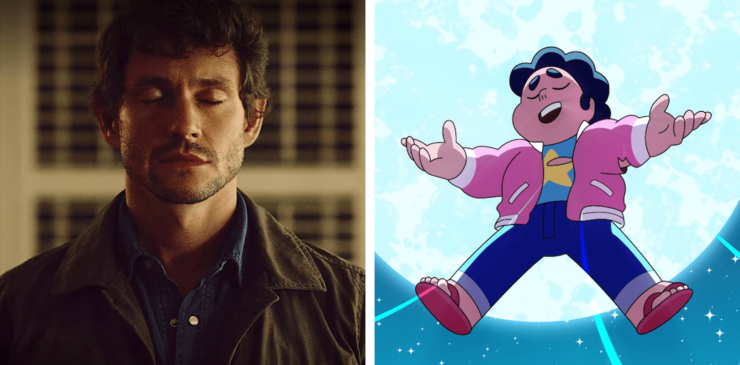Since Hannibal hit Netflix last month, a lot of people have been discovering it for the first time, while others are using the easy streaming access as a convenient excuse for a rewatch. A Tor co-worker referred to it as comfort television, and I was startled to realize I agree—this is a brilliant, difficult, graphically violent show about serial killing, but yes, watching it is relaxing.
A day later I saw a discussion about works of art that define different eras, with the poster positing that Hamilton was the defining work of the Obama era. That made me wonder about the defining works of our current era, and the more I let the question jangle through my brainmeat the more I came back to Hannibal. Although the show is a few years old (originally airing 2013-15), it seems to be coming into its own (and finding an audience) now in a way it never did while it was on NBC.
But the more I thought about it, a second answer bobbed to the surface, and revealed a startling truth: The defining works of art of this era tell the same story, and those two works are Hannibal and Steven Universe.
[Some spoilers for both Hannibal and Steven Universe.]
Now, yes, obviously, they are told through different lenses and aimed at a slightly different audience. Bryan Fuller wrings a story of love out of murder and gore. Rebecca Sugar wrings a story of trauma recovery out of a candy-colored adventure tale. They both begin in the same place, though: two special people, with a special gift of empathy, are squeezed stone dry by organizations who use their skill to their own ends.
Will Graham is described as being “on the spectrum” (the word “Asperger’s” is mentioned but is explicitly not used as a diagnosis), with all the psychologists and behavioral scientists instead veering off and saying that he has “an empathy disorder.” As far as I’ve been able to find in my research this extreme empathy is not actually a diagnosable condition, though I know plenty of artists and writers who would lay claim to it if they could. (Hell, I would.) For the first season especially, the scripts and cast treat Will’s talent as an inexplicable thing only he can do, and they accept it without too many questions. Jack Crawford brings Will to a crime scene, tells everyone to clear the area, and stands back as Will projects himself into the murderer’s mind, recreating not just the bare facts of the killing, but the murderer’s deepest motives.

One man is carving people up to look like angels so their corpses can watch over him while he sleeps, which means that he’s dying of a terminal illness. Two different men are killing people and eating their organs—but one is eating them because “he wants to honor every part of them,” while the other is doing it because “he sees people as pigs.” Despite the fact that investigating crimes this way would require wild leaps and assumptions, the show treats Will’s “findings” as, invariably, correct. Let me say this again: Will is always right. In the midst of forensic scientists, cops, psychologists, and journalists, Will Graham can create Vulcan mind-melds with murderers he has never met, and has a 100% success rate in reading their minds and even, occasionally, diagnosing illnesses they have. This is essentially a superpower. Hannibal is a specfic show, with explicitly supernatural events dotting each season and taking it further away from a simple crime procedural with each echoing clop of a Nightmare Stag’s hoof.
But the interesting thing to me is that the characters and the show itself accept the idea of “pure empathy” as a thing that can exist, and be used as a tool. The other professionals generally treat Will either as a fragile, gifted person or as a freak, but they don’t doubt his empathy powers. Because of this, the show ends up being about empathy as much as it’s about Frederick Chilton’s envy of Hannibal, the love between Jack and Bella, the Red Dragon’s attempts to transcend human form, Will and Hannibal’s impossible love for each other, or Hannibal’s desire to be the Devil made flesh and at war with God.
Steven Universe is, largely, the same story. When we meet Steven he’s a pre-pubescent, half-alien boy, being raised by his human dad and three “Crystal Gems”—aliens who adopted Earth as their home along with Steven’s mother, Rose Quartz, who kind of transformed into Steven. (It’s complicated.) Steven and his family are at war with a group of godlike Diamonds who want to either conquer Earth or destroy it. Steven’s main weapon in this fight is an extreme capacity for empathy that is recognized and accepted by the adults in his life. They encourage him to see it as a skill he can develop in addition to simply being part of his personality, but they also use this empathy as a tool in their fight with the Diamonds. Over the course of the show the other characters stand back and let him do his thing. At first his thing is bubbling dangerous “corrupted” aliens and storing them in a temple, an ability all the Crystal Gems have, but since Steven can’t fight as well, being, y’know, a literal child, they allow him to be the group’s main bubbler. Along with this, they encourage his natural healing powers—a power his mother developed in herself—and it soon becomes clear that the adult Gems expect Steven’s healing ability to surpass even that of Rose. Sometimes they wait patiently for it to get stronger, sometimes they push him to do things he’s not quite ready to do, hoping that this will force the power to manifest.
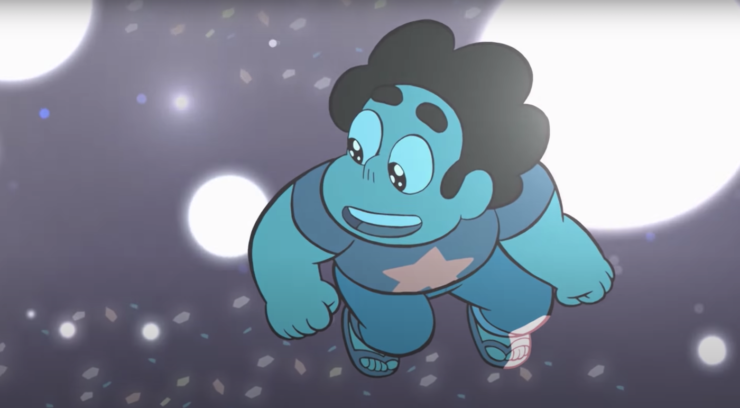
Finally his powers reach a peak while they’re not there to help. The show’s first true arc comes when a fugitive alien named Peridot tells the Gems about “the Cluster,” a mass of corrupted aliens who have been forced into a fusion and left in the center of the Earth as a ticking time bomb. At some point, the Cluster will burst apart, destroying life as we know it. The Cluster is not seen as a being, but simply as an obstacle, and the need to defeat it is threaded through the arc until it builds up to the first true “boss battle” of the show. But when the time comes to fight the Cluster, Steven instead goes full Steven: he listens to the Cluster. In his eyes, it’s not simply an object, or even an enemy—it’s a living being the same way he is. It has needs and fears. He closes his eyes and goes into a trance state (that looks quite similar to Will Graham’s, actually) and he listens to this monster, understands that it’s in excruciating pain, and nearly kills himself finding a way to help it by bubbling. At a certain point it’s simply too big for him to bubble, but by then the Cluster, watching him, has figured out how to bubble itself. Steven comes out of his trance as the Gems realize that there’s no battle to be won—only an act of healing to be witnessed.
From that point, Steven’s main arc becomes his growth as a healer. He initially adopts a corrupted Gem that he names “Centipeetle” thinking that if he just loves her enough, she’ll be OK. This doesn’t work—the damage done by the Diamonds is much too deep to be handwaved away, and he has to re-bubble her. But rather than just making this a sad 21st Century Old Yeller situation, the show checks in with his attempts to heal Centi a few more times, showing his progress through hers.
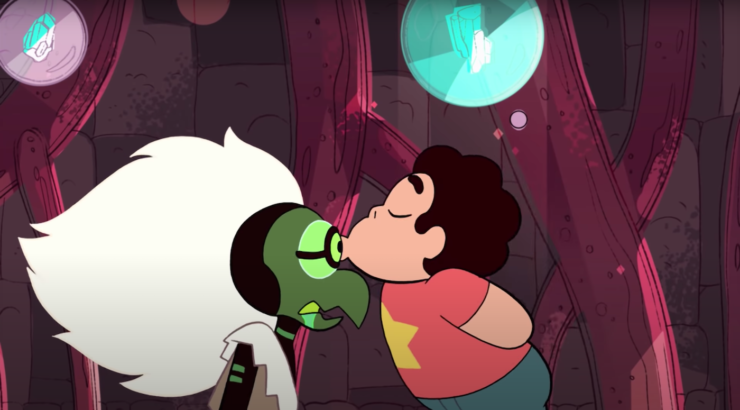
This plays out repeatedly throughout the show. Steven faces someone who, on an ordinary show, would be a monster or a villain, he talks to them, they open up to him, and, finding themselves with a choice between being alone and hurt, or having a friend like Steven, they choose the latter. This works on Peridot, Lapis Lazuli, Lars, most of the Rubies, the OffColor Gems, Spinel, and even the Diamonds—the world-conquering tyrants who are set up as the Big Bad from the opening season transform into doting aunties. And the show presents this as a good—if difficult—thing, right up until the moment it doesn’t. The older Gems and humans all accept Steven’s abilities. Sometimes they argue with him, sometimes they try to stop him for his own safety, but generally they step back and allow him to work his Steven magic. The fact that he’s a vulnerable, half-human child is only glancingly acknowledged (and usually only by his human father) because the Gems need Steven to complete his mother’s work. The humans of Beach City need him to keep them safe from the other Gems. The Universe needs him to heal the trauma of the Diamonds.
The reason Hannibal sets his hooks in Will in the first place is that he recognizes himself as a being without empathy. (Note I do not say “human” or “person”; again, the show leaves Hannibal’s true nature open to interpretation.) When he meets Will, he sees his opposite, a being with the capacity for “pure” empathy. Where Jack wants to harness this capacity as a tool to save lives (and believes he can protect Will while he does it), Hannibal thinks it’s more interesting to watch Will take his skill as far as it can go for its own sake, not as a tool for anything. So he subverts Jack, and nudges Will into empathizing so strongly with murderers that he ultimately becomes one.
In Steven Universe there is an act/condition called Fusion. It is what it says on the tin: two or more Gems “fuse” together via a ritualistic dance, creating a new being with its own unique personality. On Earth, fusion is sometimes presented as having a romantic or even sexual element. (Garnet is the result of the permafusion of partners Ruby and Sapphire, who un-fuse long enough to get married, and re-fuse right after they exchange vows.) But when Garnet fuses with Amethyst, Pearl, and later Steven, it isn’t seen as a romantic pairing—more as a spiritual merging that allows members of this family to know each other better. And when Steven fuses with his best friend Connie, their fusion is a separate thing from the romance that eventually blossoms between them.
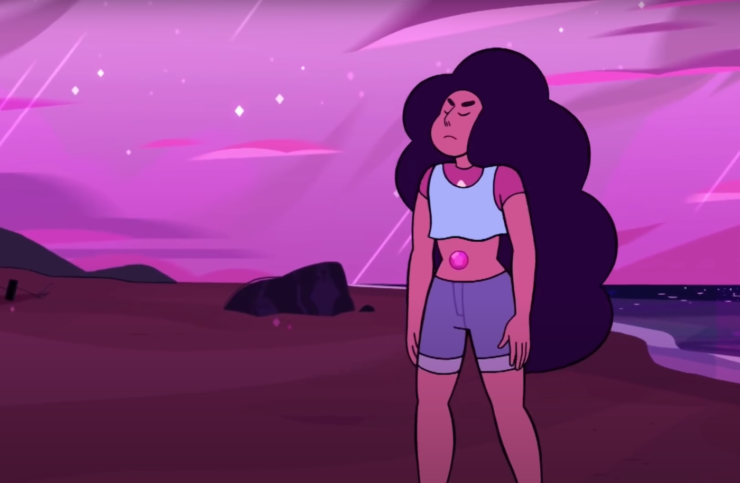
The Fusions that are created vary wildly in personality and abilities, but they are all their own people. As the show continues, we learn that on the Gem Homeworld fusion is only considered a necessary evil, a way to combine single gems for battle—and Permafusions like Garnet are seen as an abomination. We also learn that forcing a fusion without enthusiastic consent is horrifying, and can create deeply damaged new beings. The Gems aren’t sure if Steven will be able to fuse. His father Greg could never quite fuse with his mother, and it’s implied that some form of regular human sex + some sort of Gem consciousness transferal resulted in Baby Steven Quartz Universe, who has a rose quartz gem in his belly button, but who’s definitely half-human. (SU doesn’t really explore this much, given that for all its complex themes it is a kids’ show.) When Steven does fuse, it’s somewhat accidental, and it’s with Connie, with whom he feels utterly comfortable. Apart they are an exuberant half-alien 12-year-old boy and a nerdy 13-year-old girl, but together they’re Stevonnie, a nonbinary teen who knows how to drive and has the confidence to dance in a way that Steven and Connie apart are a bit too shy to do. When they un-fuse they remember being Stevonnie, but they both view them as a separate person. Later Steven fuses with the other Gems, and even with his dad. The show pretty strongly implies that Steven’s amazing empathy allows him to do something that his half-human nature probably should have made impossible, especially with the fully human Connie and Greg.
There are a couple of types of fusion in Hannibal. Will’s mental reconstructions of murders are essentially fusions with the murderers—though the two together do not form a new being. There’s also a very hallucinatory five-way sex scene between Will, Margot Verger, Alanna Bloom, Hannibal, and The Wendigo, a supernatural creature that represents Hannibal’s true nature in Will’s mind. This is presented as a fusion of a kind, with Alanna and Hannibal both realizing that Will is there with them. And then there is the finale, which to my mind is the truest fusion we see. Hannibal and Will act together to kill Francis Dolarhyde, and the three of them become one writhing mass of violence and blood. Here, finally, Will and Hannibal penetrate another man together to somewhat replace the fact that they don’t exactly want to penetrate each other—mere sex isn’t enough, and eating each other would be too final—and they do form a new creature, called #MurderHusbands.
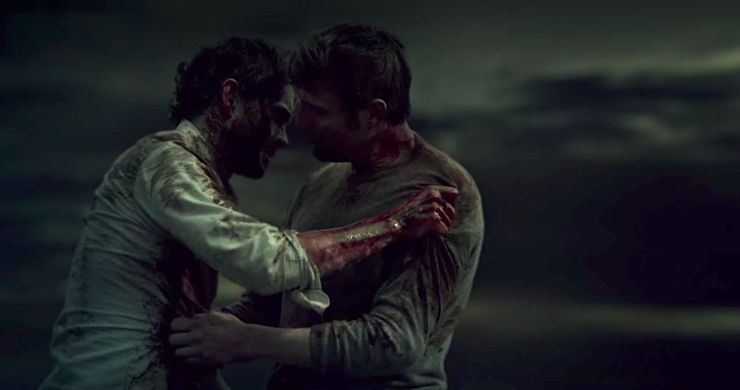
But the thing that hit me most as I thought about these shows together was that in the end of both Hannibal and Steven Universe, all that empathy curdles, and they both become the monster. About halfway through Season Two of Hannibal, Will Graham finally, gently, unhooks the leash he’s kept on the secret part of his nature. He becomes a murderer. He barks at Jack Crawford without fear. He resumes his therapy with Hannibal not as a confused, victimized patient but as an equal, who is just as amused by Hanni’s foibles as the good doctor used to be by his. His tics disappear, he makes prolonged eye contact, he dresses like a professional detective rather than a professional fisherman, and most significantly, it no longer takes him a few minutes of panting and shivering to find a killer’s Design. He takes his glasses off, he closes his eyes, and he’s there. Pure empathy. And years later, when Will gets called back into service to hunt the Red Dragon, he understands that he can’t unlock his empathy powers and remain Will. In order to connect to the Red Dragon he becomes him. In order to connect to Hannibal he becomes him. And the three go out together in an orgy of blood that stands not just as one of the greatest finales of all time, but also as History’s Gothest Moment since the fall of fucking Rome.
In Steven Universe: Future we learn that in all of his 16 years on earth, Steven has never been to a doctor. He’s faced death countless times, but never gotten to talk about that with anyone. He’s so accustomed to being everyone else’s endless font of empathy that it doesn’t occur to him that maybe he needs someone to listen to him. The stress and confusion literally turn him into a monster, because, suddenly unable to help people, that’s what he believes himself to be.
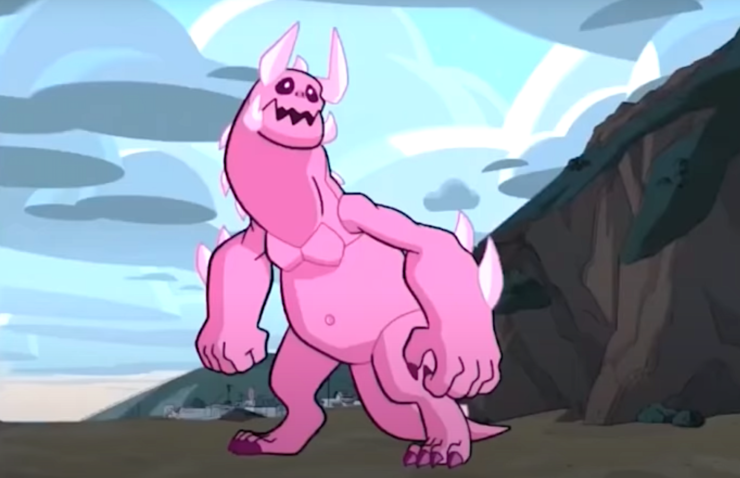
It takes Connie, a human, to point out that the giant pink Godzilla-esque creature who can only communicate in screams is Steven, and everyone needs to pull together to let Steven know they’ll be his support network just as he was theirs. And because writer Rebecca Sugar is a genius, they also make it a plot point that he goes into therapy. He can’t just depend on his friends for everything—he needs a space carved out to talk through his childhood with a professional.
As Hannibal begins with Will being dragged into therapy sessions that turn him into a monster and ends with him destroying himself and his therapist, Steven Universe: Future ends with Steven using therapy to understand that he isn’t a monster, and that he does, in fact, get to have a future. There is life after saving the world.
As I write this there are people in camps on my country’s border; they have been there for years. The prison at Guantanamo has been fully armed and operational since 2002. There was a representative of the current political administration who used the phrase “Holocaust centers” rather than concentration camps, repeatedly. Black people are still being murdered across the country for such cosmic sins as “driving” and “walking through a neighborhood.” One of the great writing heroes of my youth has decided to devote her time and her platform to hateful rhetoric that is hurting queer people, emotionally, right now, and will continue to be used by lawmakers and parents to hurt queer kids in the future. We’ve spent the spring watching as elected officials crunch numbers to figure out how many pandemic deaths are too many, and the answer is, uhhh, not what you might hope, if you’re a mortal human. And there are two reasons why this litany of horror is even possible: (1) a large number of powerful people cannot empathize with anyone different from themselves, and (2) because powerful people throughout history have failed at empathy, they never bothered enshrining rights into law that could maybe protect people different from themselves. Because that’s the problem—people can talk about art and representation and empathy and walking in other people’s shoes until Hannibal finally gets a fourth season, but unless rights are written into laws, and unless those laws are enforced by a governing body that respects them, empathy ain’t shit.
And obviously I’m sitting here in New York, where I’m relatively safe (I mean, aside from the deadly virus and the riot gear-outfitted police) and I write for a pop culture website, so on a certain level it feels extremely disingenuous—possibly even evil—to invoke all of this? But at the same time, with any platform must come great responsibility?
Which is why I’m going to nominate these two shows as the pieces of art that will survive this time, if anything does. Because of everything I’ve watched over the last few years these are the only two that tried to make art about empathy. Not using empathy, or arguing its efficacy, but ABOUT it, as a theme and a plot point. What empathy can achieve and how it can fail. And how it will fail if the more empathetic people in a society are left to fend for themselves, and lack support from those with power.
It’s kind of like the “smartest guy in the room” trope. It was pretty popular for a while, but as Charlie Jane Anders pointed out on io9 back in 2014 (!!!), it was kind of dumb? The smartest guy in the room only gets to be the smartest if everyone else in the room agrees to it. If you’re the smartest guy in a room full of people who don’t understand you, you’ll sound like an asshole or a raving lunatic, those in power won’t implement your ideas, and you’ll never get a chance to prove that this whole “consulting detective” idea will totally work, just trust me everyone.
These shows instead created a new trope, the most empathetic guy in the room. And they showed over the course of several seasons that if you’re expending that much empathy, but no one else is, it will turn you into a monster. Hannibal and Steven Universe aren’t, in the end, about Will and Steven and how awesome they are—they’re showing us that every single person in the room needed to step up and become empathy superheroes too. The only way this works is if everyone does the work of trying to understand others. What we’ve seen over the last few weeks is the effect of people stepping outside of their own lives and trying to understand what it would be to live in fear every day because of a system that was built and armed against you. We saw it with the growing acceptance of enshrining LGBTQ rights in law, and we’re seeing it now as more and more white faces turn up, finally, at Black Lives Matter marches.
Empathy is not enough. Empathy is the bare minimum, the first step that must lead to legal rights, to a society that understands itself to be for everyone, not only for the elite rich white few. But we’re currently living in a world that won’t even demand that bare minimum from most of its leaders and it is killing us. Which is why I am humbly nominating the two best works of art on empathy that I know to be the two that stand for this era.
Maybe if Leah Schnelbach dedicates their life to Hannibal thinkpieces, we’ll get a fourth season? It’s worth a shot. Come join them in the well of empathy and understanding that is Twitter!










